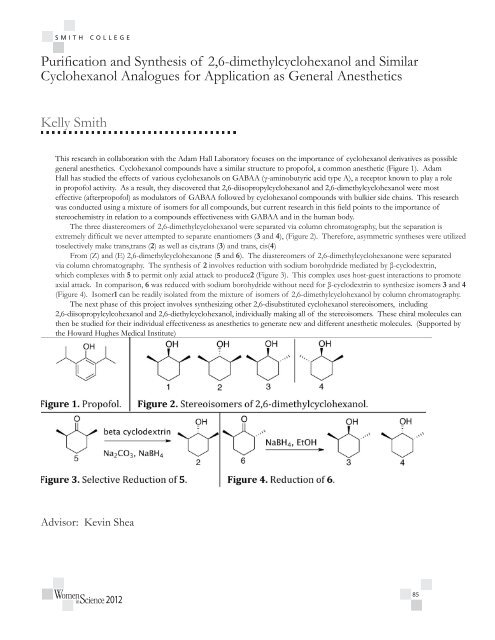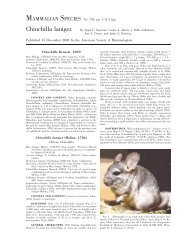Brugia Malayi - Clark Science Center - Smith College
Brugia Malayi - Clark Science Center - Smith College
Brugia Malayi - Clark Science Center - Smith College
Create successful ePaper yourself
Turn your PDF publications into a flip-book with our unique Google optimized e-Paper software.
Purification and Synthesis of 2,6-dimethylcyclohexanol and Similar<br />
Cyclohexanol Analogues for Application as General Anesthetics<br />
Kelly <strong>Smith</strong><br />
This research in collaboration with the Adam Hall Laboratory focuses on the importance of cyclohexanol derivatives as possible<br />
general anesthetics. Cyclohexanol compounds have a similar structure to propofol, a common anesthetic (Figure 1). Adam<br />
Hall has studied the effects of various cyclohexanols on GABAA (γ-aminobutyric acid type A), a receptor known to play a role<br />
in propofol activity. As a result, they discovered that 2,6-diisopropylcyclohexanol and 2,6-dimethylcyclohexanol were most<br />
effective (afterpropofol) as modulators of GABAA followed by cyclohexanol compounds with bulkier side chains. This research<br />
was conducted using a mixture of isomers for all compounds, but current research in this field points to the importance of<br />
stereochemistry in relation to a compounds effectiveness with GABAA and in the human body.<br />
The three diastereomers of 2,6-dimethylcyclohexanol were separated via column chromatography, but the separation is<br />
extremely difficult we never attempted to separate enantiomers (3 and 4), (Figure 2). Therefore, asymmetric syntheses were utilized<br />
toselectively make trans,trans (2) as well as cis,trans (3) and trans, cis(4)<br />
From (Z) and (E) 2,6-dimethylcyclohexanone (5 and 6). The diastereomers of 2,6-dimethylcyclohexanone were separated<br />
via column chromatography. The synthesis of 2 involves reduction with sodium borohydride mediated by β-cyclodextrin,<br />
which complexes with 5 to permit only axial attack to produce2 (Figure 3). This complex uses host-guest interactions to promote<br />
axial attack. In comparison, 6 was reduced with sodium borohydride without need for β-cyclodextrin to synthesize isomers 3 and 4<br />
(Figure 4). Isomer1 can be readily isolated from the mixture of isomers of 2,6-dimethylcyclohexanol by column chromatography.<br />
The next phase of this project involves synthesizing other 2,6-disubstituted cyclohexanol stereoisomers, including<br />
2,6-diisopropylcylcohexanol and 2,6-diethylcyclohexanol, individually making all of the stereoisomers. These chiral molecules can<br />
then be studied for their individual effectiveness as anesthetics to generate new and different anesthetic molecules. (Supported by<br />
the Howard Hughes Medical Institute)<br />
Advisor: Kevin Shea<br />
2012<br />
85

















